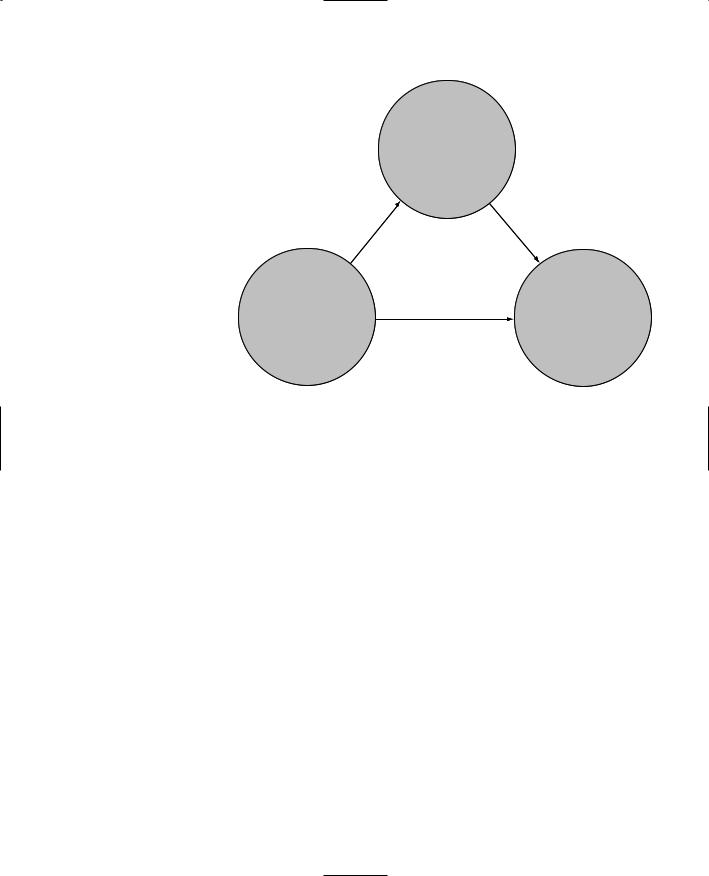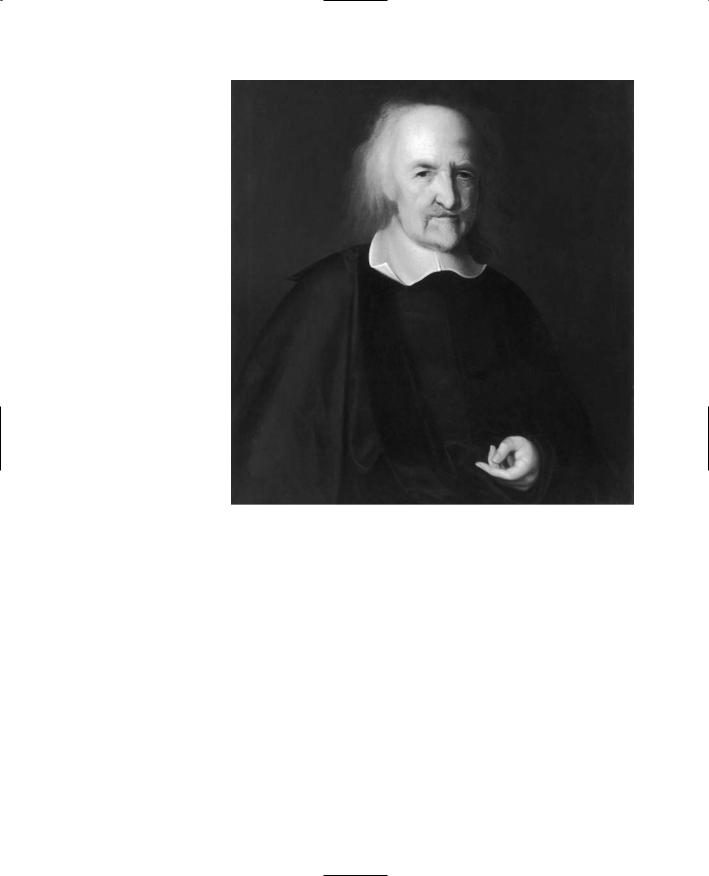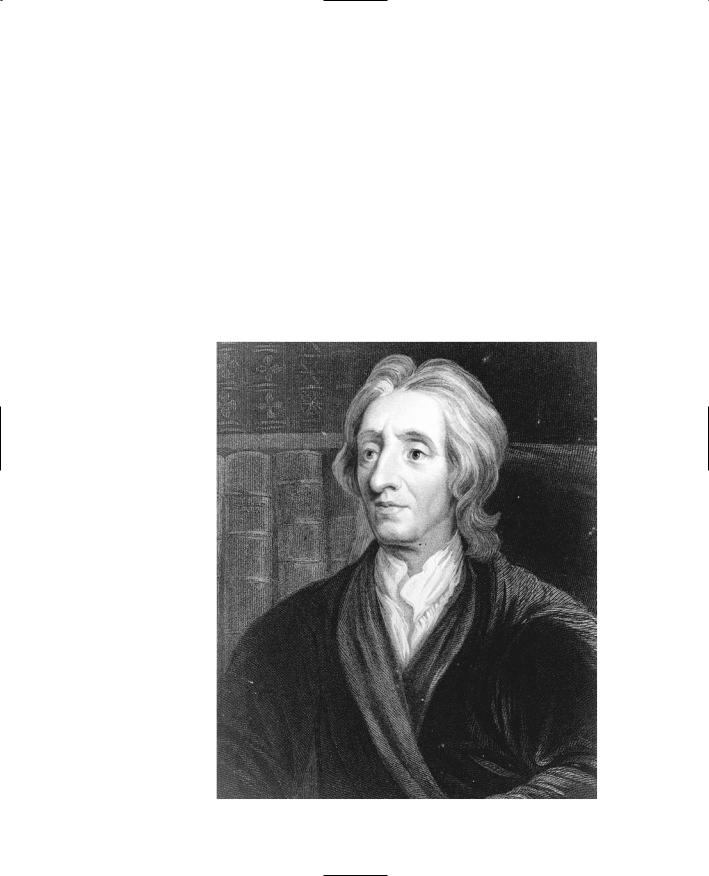
Liberalism
.pdf
C H A P T E R 3
LIBERALISM
Over himself, over his own body and mind, the individual is sovereign.
John Stuart Mill, On Liberty
For more than three centuries, the hallmark of liberalism has been the attempt to promote individual liberty. But this very broad goal leaves room for liberals to disagree among themselves as to what exactly liberty is and how best to promote it. Indeed, this disagreement is now so sharp that liberalism is split into two rival camps of “neoclassical” and “welfare” liberals. Later in this chapter we shall see how this split occurred. But first we need to look at that broad area of common ground on which
all liberals meet—the desire to promote individual liberty.
The words liberal and liberty both derive from the Latin liber, meaning “free.” “Liberal” did not enter the vocabulary of politics until early in the nineteenth century, however, long after “liberty” was widely used as a political term—and at least a century after ideas now regarded as liberal were in the air. Before the nineteenth century, “liberal” was commonly used to mean “generous” or “tolerant”—an attitude that supposedly befit a “gentleman,” just as a “liberal education” was meant to prepare a young gentleman for life. “Liberal” still means generous or tolerant, of course, as when someone says that a teacher follows a liberal grading policy or a child has liberal parents. But nowadays, through an extension of this common use, “liberal” more often refers to a political position or point of view.
The first clear sign of this political use occurred in the early nineteenth century when a faction of the Spanish legislature adopted the name Liberales. From there the term traveled to France and Great Britain, where the party known as the Whigs evolved by the 1840s into the Liberal Party. These early liberals shared a desire for a more open and tolerant society—one in which people would be free to pursue their own ideas and interests with as little interference as possible. A liberal society was to be, in short, a “free” society. But what makes a society “free”? What is freedom and how can we best promote it? These questions have occupied liberals for more than three centuries now, providing the grounds not only for arguments among liberals but also for disputes between liberalism and other ideologies.
45

46 |
PART TWO The Development of Political Ideologies |
LIBERALISM, HUMAN NATURE, AND FREEDOM
In Chapter 1 we noted that some conception of human nature provides the underpinnings for every political ideology. In the case of liberalism, the emphasis on individual liberty rests on a conception of human beings as fundamentally rational individuals. There are, we shall see, significant differences among liberals on this point. But in general liberals stress individual liberty largely because they believe that most people are capable of living freely. This belief sets them apart from those who believe that human beings are at the mercy of uncontrollable passions and desires, first pushing in one direction, then pulling in another. Liberals acknowledge that people do have passions and desires, but they maintain that people also have the ability, through reason, to control and direct their desires. Most women and men, they insist, are rational beings who know what is in their own interests and, given the opportunity, are capable of acting to promote those interests.
Liberals generally agree that self-interest is the primary motive for most people. Some argue that self-interest should be given free rein, while others respond that it should be carefully directed to promote the good of all; but most hold that it is wisest to think of people as beings who are more interested in their own good than in the well-being of others. This implies, in turn, that all these rational, self-interested men and women will find themselves competing with one another in their attempts to promote their personal interests. This is healthy, liberals say, as long as the competition remains fair and stays within proper bounds. Exactly what is fair and where these proper bounds lie is a subject of sharp disagreement among liberals, as is the question of how best to promote competition. For the most part, though, liberals are inclined to regard competition as a natural part of the human condition.
On the liberal view, then, human beings are typically rational, self-interested, and competitive. This implies that they are capable of living freely. But what does it mean to live in this way? How, that is, do liberals conceive of freedom? To answer this question, let us employ the model introduced in Chapter 1 depicting freedom as a triadic relationship involving an agent who is free from some obstacle to pursue some goal. In the case of liberalism, the agent is the individual. Liberals want to promote the freedom not of a particular group or class of people but of each person as an individual. To do this, they have sought to free people from a variety of restrictions or obstacles. In the beginning liberals were most concerned with removing social and legal barriers to individual liberty, especially social customs, ties of feudal dependence, and religious conformity. Since then other liberals have claimed that poverty, racial and sexual prejudice, ignorance, and illness are also obstacles to individual liberty. But in spite of these differences, liberals agree that the individual must be free to decide for himself—and, more recently, herself—what goals to pursue in life. Most liberals have believed, that is, that the individual is the best judge of what is in his or her interest, so each person ought to be free to live as he or she sees fit—as long as the person does not choose to interfere with others’ freedom to live as they see fit. (See Figure 3.1.)
That is to say that equality is also an important element in the liberal conception of freedom. In the liberal view each person is to have an equal opportunity to enjoy liberty. No person’s liberty is more important or valuable than any other’s. This does not mean that everyone is to be equally successful or to have an equal share of the good things of life, whatever they may be. Liberals do not believe that everyone can or should be equally

CHAPTER 3 Liberalism |
47 |
OBSTACLE:
laws, customs, or conditions that block individual choice
AGENT: |
GOAL: |
the individual |
to live as one chooses |
FIGURE 3.1 The liberal view of freedom.
successful—only that everyone should have an equal opportunity to succeed. Liberalism thus stresses competition, for it wants individuals to be free to compete on an equal footing for whatever they count as success. Anything that prevents a person from having an equal opportunity—whether it be privileges for the aristocracy, monopolies that block economic competition, or discrimination based on race, religion, or gender—can be an obstacle to a person’s freedom that ought to be removed.
Liberalism, in short, promotes individual liberty by trying to guarantee equality of opportunity within a tolerant society. In the English-speaking world, these ideas are so much a part of our lives and our thinking that they seem natural. But that is because these liberal ideas are so much a part of our heritage throughout Western civilization in general. These ideas were not always taken for granted, however, not even in England and Europe. To appreciate their full significance we need to see how liberalism began as a reaction against the European society of the Middle Ages.
HISTORICAL BACKGROUND
Medieval Origins
The origins of liberalism can be traced to a reaction against two of the characteristic features of medieval society in Europe: religious conformity and ascribed status. This reaction, which developed over the course of centuries, took different forms in different times and places. By the time “liberal” entered the political vocabulary in the early nineteenth century, however, a distinctive political viewpoint had clearly emerged.

48 |
PART TWO The Development of Political Ideologies |
Religious Conformity. Liberals called for freedom of religion and separation of church and state. These ideas ran counter to the dominant ways of thinking in the Middle Ages, when church and state were supposed to be partners in the defense of Christendom. Indeed, there was no clear distinction between church and state in medieval Europe. For its part, the Christian Church saw its mission as saving souls for the Kingdom of God— something that could best be done by teaching and upholding orthodoxy, or “correct belief.” Those who took an unorthodox view of Christianity or rejected it altogether thus threatened the Church’s attempts to do what it saw as the work and will of God. In response to these threats, the Church used its powers, and called on the kings and other secular authorities to use theirs, to enforce conformity to Church doctrine. For their part, the secular rulers were usually willing—out of either religious conviction or a desire to maintain order in their domains—to suppress those whom the Church considered heretics or infidels. Throughout medieval Europe, then, religious and political authorities joined forces to ensure conformity to the doctrines of the Roman Church, which they believed to be the true and universal path to the Kingdom of God.
Ascribed Status. The other feature of medieval society to which early liberals objected was ascribed status. In a society based on ascribed status, a person’s social standing is fixed, or ascribed, at birth, and there is little that he or she can do to change it. This stands in contrast to a society based on achieved status, in which everyone is supposed to have an equal opportunity to work his or her way to the top—or, for that matter, to the bottom—of society. But equality of opportunity was by no means the ideal of medieval society. To be sure, Christians in the Middle Ages professed that all people are born equal in the eyes of God, but this kind of equality was compatible in their eyes with great inequalities in life here on earth. What counted was the state of one’s soul, not one’s status in society.
Yet status mattered very much in earthly life, for one’s position and prospects were fixed by his or her social “rank,” “order,” or “estate.” This was especially true under feudalism, which became the main form of social and economic organization in Europe after the disintegration of Charlemagne’s empire in the ninth century. Under feudalism, an intricate web of relationships developed in which one knight, the lord, would give the use of land to a lesser knight, the vassal, in return for military service. The vassal might then divide the land into parcels to be offered to others, who then, in exchange for various services, became his vassals. In the beginning the original lord retained ownership of the land, with the vassal receiving only the right to use it and enjoy its fruits. These relationships gradually became hereditary, however, leading to a complicated network of ranks, statuses, and loyalties.
In one respect, though, feudalism simplified matters by reinforcing the existing tendency to divide society into two broad classes of people: nobles and commoners. As feudal relationships were passed down the generations, a distinct class of landowning nobles or aristocrats took shape. These nobles thought themselves naturally superior to the commoners, who were the great majority of the people. They also believed that their noble birth entitled them to exercise authority over the commoners and to enjoy privileges and liberties unavailable to common men and women.
This emphasis on social “rank” or “estate” was reflected in the parliaments or estatesgeneral that began to appear in the late Middle Ages. These political bodies, usually summoned by kings, spoke for the different orders of society. The Estates-General of France,

CHAPTER 3 Liberalism |
49 |
for instance, which first convened in 1302, comprised representatives of the clergy (the First Estate), the nobility (the Second Estate), and the commoners (the Third Estate). Because the members of this last group lived mostly in the cities and towns—bourgs in French—they were called the bourgeoisie. There were no representatives for those who were not free, such as the serfs.
Serfs (from the Latin servus, meaning “slave”) were commoners, but they were not free. They were peasants, or agricultural laborers. Unlike free peasants, the serfs owned no land. Instead, they farmed small plots of land owned by the lord of the manor, and from their plots they had to provide for their families and pay rent to the lord, typically in the form of crops.
The most distinctive feature of serfdom, however, was the serfs’ lack of freedom to choose where to live and what work to do. Serfs were often legally “attached” to the land or the person of the lord. By custom and law they were bound—hence the term, “bondsman”—either to remain on and work the land where they were born or, if attached to a person, to serve the lord wherever required. In exchange, serfs received from the lord protection. If the serfs thought this a poor bargain, there was nothing they could do, as a rule, to earn release from serfdom. Some tried to win their freedom by force of arms; others ran away to the towns and cities; and still others accepted their condition as part of the natural course of life, although perhaps cherishing a hope that their lord might one day free them.
Everyone—whether a serf, a noble, or a free commoner—was born into a certain rank or estate in medieval Europe and could do little to change it. The Church provided an exception to this rule, for people from all ranks of society could hope to find a place among the clergy. In other respects, though, medieval society was firmly rooted in ascribed status. Nobles were those born into the nobility, for the most part, while the children of free commoners and serfs were virtually locked into the social position of their parents. No amount of effort or ability could significantly improve their stations in life. Even freedom was a matter of social position, with different liberties attached to different levels of status in society. For example, in the Magna Carta, the Great Charter of rights that the feudal barons of England forced King John to accept in 1215, the king agreed that “No free man shall be taken, or imprisoned, . . . or outlawed, or exiled, or in any way destroyed . . . except by lawful judgment of his peers or by the laws of the land.” But in this case “free man” (liber homo) referred only to the barons and other nobles. Those of lesser rank could still be taken, imprisoned, or killed without the lawful judgment of their peers—without, that is, a trial by a jury.
Against this society rooted in ascribed status and religious conformity, liberalism emerged as the first distinctive political ideology. But this reaction did not take definite shape until a number of social, economic, and cultural changes disturbed the medieval order. Many of these changes were directly related to the outburst of creativity in the fourteenth and fifteenth centuries known as the Renaissance. But there was also the Black Death, an epidemic that devastated Europe from 1347 to 1351, killing about one of every three people. This epidemic opened new opportunities for survivors from the lower ranks of society and loosened the rigid medieval social structure. The expansion of trade and commerce in the late Middle Ages played a part in the breakdown of the medieval order too, as did the wave of exploration set in motion by this expansion. Christopher Columbus’s attempt to find a new trade route to Asia is noteworthy in this regard, for he discovered what was, for Europeans, an entirely

50 |
PART TWO The Development of Political Ideologies |
new world—a New World that became a symbol of great new possibilities. But of all the historical developments that contributed to the decline of the medieval order and the rise of liberalism, the most important was the Protestant Reformation.
The Protestant Reformation
The Protestant Reformation can be dated from 1521, the year in which the Roman Catholic Church excommunicated Martin Luther. Luther (1483–1546) was a priest and professor of theology at the University of Wittenberg when he posted his famous Ninety-five Theses on the door of the church at Wittenberg in 1517. By themselves, the Ninety-five Theses were not a direct threat to the authority of the Church. Their immediate purpose was to call for a debate on the sale of “indulgences,” which were issued on the authority of the Pope to raise money for Church projects—in 1517, the rebuilding of St. Peter’s Basilica in Rome. Although the purchase of an indulgence was only supposed to release a sinner from some acts of penance, eager salesmen sometimes led people to believe that an indulgence could secure a place in heaven. This provoked Luther to issue his challenge to a debate.
With the aid of a relatively new invention, the printing press, Luther’s theses circulated quickly through the German principalities and found a receptive audience among Christians disturbed by the corruption of the Church. They also caught the attention of the German nobles, many of whom regarded the Church as their main rival for earthly power. The resulting furor led Luther’s superiors in the Church to command him to admit that he was mistaken and to submit to the authority of the Pope. But Luther refused, saying, as legend has it, “Here I stand. I can do no other.” Thus began the Reformation.
The Church, in Luther’s view, had vested too much authority in priests and too little in the Bible. In place of the Church’s emphasis on tradition, rituals, and sacraments, Luther favored strict attention to scripture, the word of God. And in place of the Church’s emphasis on the authority of priests, bishops, and the Pope, Luther favored the “priesthood of all believers.” All that matters is faith, he declared, and the only way to nurture faith is to read the Bible and do as God there commands us to do. With that in mind, Luther and his colleagues translated the Bible into German to make it accessible to those who could not read Latin.
Despite some early remarks defending freedom of conscience, Luther never meant to encourage people to believe and worship in whatever way they chose. Apparently he expected that everyone who read the scriptures could not help but understand them as he did. But that did not happen. To the contrary, Luther’s proclamation of the “priesthood of all believers,” with its stress on individual conscience, opened the floodgates for a variety of interpretations of the Bible and a profusion of Protestant sects. Luther neither foresaw nor welcomed this development. Nor did he intend to separate church from state. Indeed, one reason that Luther’s challenge to the supremacy of the Church succeeded where earlier challenges had failed is that Luther was able to win the protection of the German princes, many of whom saw in the controversy a welcome opportunity to gain wealth and power at the Church’s expense. In any case, in Germany and elsewhere the immediate effect of the Reformation was to forge an alliance between a king or prince, on the one hand, and the leaders of a reformed or Protestant church, on the other. In this way various local or national churches began to challenge the authority of the universal church.

CHAPTER 3 Liberalism |
51 |
England soon provided the clearest example of a national church. There King Henry VIII (r. 1509–1547), angered by the Pope’s refusal to grant him permission to divorce his first wife, declared the Church of England separate from Rome and, with the approval of the English Parliament, made himself its head. A church of a different sort emerged in Geneva. Now part of Switzerland, Geneva was an independent city-state when Jean (or John) Calvin (1509–1564), a French Protestant, became its leader in political as well as in religious matters. Like most of the other Protestants or reformers, in fact, Calvin was no more inclined to distinguish politics from religion, or church from state, than his Roman Catholic opponents were. The point of the Reformation was not to enable people to believe as they saw fit, but literally to reform the Church so that people could believe as reformers thought they should. Under Calvin’s leadership, Geneva became a theocracy. The law of the city was to be a direct reflection of God’s will, to the extent that a pastor could enter a house at any hour of the day or night to make sure that no one was violating God’s commandments.
Where the political authorities remained loyal to the Catholic Church, they often tried to suppress the Protestants. In such cases Luther and Calvin usually counseled their followers not to resist their rulers, since God gave rulers their power to do His will. Later, however, some of Calvin’s followers concluded not only that resistance is sometimes justified but also that the people have a right to overthrow any ruler who denies them the free exercise of their religion. By this they meant the exercise of their form of Calvinism, to be sure, because few of them wanted to allow the free exercise of other religions. Yet their arguments for freedom of conscience, which rested in part on the claim that government receives its authority from the consent of the people, planted the seeds of the argument in favor of religious toleration.
Before these seeds could sprout, however, people had to be convinced that it was either wrong or simply impossible to replace enforced conformity to the Roman Church with enforced conformity to one or another of the Protestant churches. This conviction did not begin to develop until the seventeenth century, and then only after a series of bloody religious wars persuaded some, such as John Locke, that it was better to tolerate some differences of religion than to try to win converts at the point of a sword.
Quite unintentionally, then, the Protestant reformers prepared the way for liberalism. By teaching that salvation comes through faith alone, Luther and the other reformers encouraged people to value individual conscience more than the preservation of unity and orthodoxy. Moving from individual conscience to individual liberty was still a radical step for the time, but it was a step that the early liberals took. Thus, liberalism began as an attempt to free individuals from the constraints of religious conformity and ascribed status. It also began, as most ideologies have begun, as an attempt to bring about a fundamental transformation of society. It was, in short, revolutionary. To see this more clearly, we need to look at the great revolutions of the seventeenth and eighteenth centuries.
LIBERALISM AND REVOLUTION
England
After defeating the Spanish Armada in 1588, England entered the seventeenth century more secure and powerful than it had ever been. Queen Elizabeth I was on the throne, and William Shakespeare was writing plays. Then came contributions to

52 |
PART TWO The Development of Political Ideologies |
literature by John Donne and John Milton, to philosophy by Thomas Hobbes and John Locke, and to science by Isaac Newton and William Harvey, the physician who discovered the circulation of blood. Meanwhile, commerce and exploration flourished as English colonies sprang up in North America and India.
But the seventeenth century was also a time of turmoil for England. Elizabeth was succeeded in 1603 by a distant cousin, James Stuart, King of Scotland. The new king soon found himself engaged in a power struggle with Parliament, a struggle that grew more heated during the reign of his son, Charles I. Money was often at the root of the conflict, with Charles insisting that he had a right, as king, to gather revenue through taxes, while Parliament insisted that this was its right as the body representing the people of England. In 1642 the conflict erupted into civil war.
The war between Crown and Parliament was further fueled by religious, social, and economic elements. For many people the war was primarily a religious conflict. As king, Charles I was the official head of the Church of England, and all the English were expected to conform to the beliefs and practices of that Church. Those loyal to the Church of England tended to support the king, then, while the dissenting Puritans took the side of Parliament. The Puritans often disagreed with one another— some were Presbyterians, some Independents or Congregationalists, some Separatists—but all wanted to “purify” the Church of England of the traces of Catholicism they thought it had retained. Their hope, in general, was to enforce conformity to their religion, just as those who supported the established church sought to enforce conformity to theirs. The social and economic divisions are less clear, but it seems that the landowning aristocracy supported the king while the middle class— the “gentlemen” landowners and the merchants—generally sided with Parliament.
In the English Civil War pen and ink played as great a part as bullets and swords. From every side came a vast outpouring of pamphlets, treatises, sermons, and even major works of political theory. In the previous chapter we noted the efforts of James Harrington, who argued for a republican form of government, and of the Levellers, who pressed the case for a more democratic form. Now we must take note of the first major work of political philosophy to bear the distinctive stamp of liberalism, Thomas Hobbes’s Leviathan.
Hobbes (1588–1679) wrote Leviathan in France, where he had fled to avoid the war, and published it in 1651, two years after the beheading of Charles I brought the war to an end. There was nothing new in the conclusion he reached in Leviathan. Like St. Paul and many others, Hobbes maintained that the people of a country should obey those who have power over them. But he refused to base this conclusion on the simple claim that this was God’s will. Even though Hobbes cited scripture, his argument was fundamentally secular—and, he thought, “scientific”—as it was based on self-interest rather than divine commands.
According to Hobbes, the individual should obey whoever is in power, as long as the person or persons in power protect the individual. To provide protection or security is the only reason for government in the first place. To prove his point, Hobbes asked his readers to imagine that they were in a state of nature, a condition of perfect freedom in which no one had any authority over them. In such a state, he said, all individuals are equal—no one is born to hold a higher rank or status than anyone else— and have a natural right to do as they wish. The problem is human nature: “I put for a general inclination of all mankind, a perpetuall and restlesse desire of Power after

CHAPTER 3 Liberalism |
53 |
Thomas Hobbes (1588–1679)
power, that ceaseth onely in Death.”1 This “restlesse desire” for power leads individuals into conflict with one another and turns the state of nature into a “warre of every man against every man” where life can be nothing but “solitary, poore, nasty, brutish, and short.”2 Hobbes’s state of nature thus became a state of war.
Nothing, in Hobbes’s view, could be worse than this. So the fearful, selfinterested, and rational individuals in the state of nature enter into a social contract to establish political authority. To provide for their security, they surrender all but one of their rights—the right to defend themselves—to those to whom they grant authority. On Hobbes’s argument, then, government is founded in the consent of the people. But by their consent, the people authorize the sovereign—the person or persons in power—to do anything necessary to maintain order and peace. This includes the power to force everyone to worship as the sovereign requires, for Hobbes saw religious differences as one of the leading sources of conflict. For the sake of security, then, the people grant the sovereign absolute, unlimited power, retaining only the right to defend themselves when the sovereign directly threatens them.
Given this conclusion, the claim that Leviathan bears the distinctive stamp of liberalism may seem odd. Liberals certainly have not made a habit of supporting absolute

54 |
PART TWO The Development of Political Ideologies |
rulers or enforcing religious conformity. What gives Hobbes’s theory a distinctly liberal tinge is not his conclusion, however, but his premises. Individuals are equals, on Hobbes’s account, and everyone has a natural right to be free. They create government through their consent in order to protect their interests. In these respects, Hobbes’s position is very much that of a liberal or, as some prefer to say, a “pro- toliberal”—that is, one who articulated the main premises of an emerging liberal ideology. It remained for John Locke to use these premises to reach conclusions that were definitely liberal.
Locke (1632–1704) was sixteen years old when Charles I was beheaded and Parliament abolished the monarchy. Yet only eleven years later, Parliament invited the son of the late king to return from his exile in France—where Hobbes had been one of his tutors—to restore the monarchy. This Restoration brought relief from political turmoil, but it proved to be only temporary. As Charles II grew older, it became clear that he would leave no legitimate heir to the throne. This situation placed his brother James in position to be the next king and aroused the suspicion that James, a Catholic, would try
John Locke (1632–1704)
